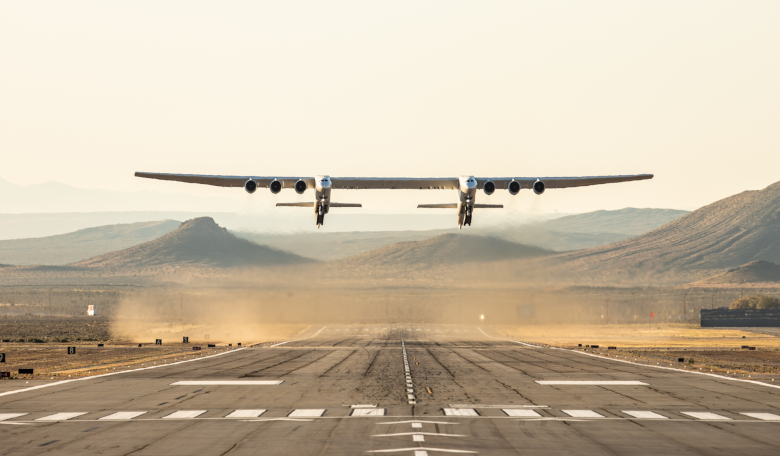It has a wingspan bigger than a football field and is designed to launch rockets from the air, Statolaunch, the world’s largest aircraft effortlessly made its first flight at the weekend in a low-key event at the Mojave Air and Space Port in Mojave, California.
The huge all-composite aircraft, named Roc, is the brainchild of the late billionaire Paul Allen who envisaged a mobile launch platform that provides convenient and affordable access to space from under the wings of a plane, rather than lofting payloads to orbit by blasting off in a rocket from a vertical launch pad.
Stratolaunch debuted last year and had been conducting runaway tests with the huge plane in recent months, but its maiden flight was not officially announced beforehand by the company. It was though spotted by keen photographers at the airport who were initially unaware of the significance of the flight and a flurry of photographs were quickly released to social media once they realised what was going on.
“What a fantastic first flight,” said Jean Floyd, CEO of Stratolaunch after Roc landed. Floyd, who has more than 30 years of experience in the aerospace industry and was recently Vice President and General Manager for the civil and defense division of Orbital ATK, added; “Today’s flight furthers our mission to provide a flexible alternative to ground launched systems. We are incredibly proud of the Stratolaunch team, today’s flight crew, our partners at Northrup Grumman’s Scaled Composites and the Mojave Air and Space Port.”
Roc took off at 6:58 am PDT (13:58 GMT) and stayed in the air for 2.5 hours. During this time the pilots evaluated handling qualities and aircraft performance before landing successfully back at the Mojave Air and Space Port.
The flight itself was smooth said Scaled Test Pilot, Evan Thomas in a press briefing afterwards, which is exactly what you want the first flight to be, he added. “And for the most part, the airplane flew as predicted which is again exactly what we want… We saw a few little things that were off nominal, but really for a first flight, it was spot on.”
Stratolaunch was established in 2011 by Microsoft co-founder Paul G. Allen to get game-changing ideas off the ground by making space launch more reliable. Sadly, the entrepreneur died last year so he did not get to see his monumental vision get off the ground.
“We all know Paul would have been proud to witness today’s historic achievement,” said Jody Allen, Chair of Vulcan Inc. and Trustee of the Paul G. Allen Trust. “The aircraft is a remarkable engineering achievement and we congratulate everyone involved.”
“It was an emotional moment for me to personally watch this majestic bird take flight and to see Paul Allen’s dream come to life in front of my very eyes,” reiterated Floyd.
Allen, who started up his pursuit in spaceflight after leaving Microsoft when he was diagnosed with Hodgkin’s disease, had an estimated net worth of $20 billion at the time of his death.
Prior to Stratolaunch, he spent $28 million to fund SpaceShipOne – a joint venture with Scaled Composites to create an experimental air-launched rocket-powered aircraft – which won the renamed Ansari X Prize in October 2004. After winning the prize, the craft was immediately retired from active service.
Stratolaunch follows a similar principle to Virgin Galactic’s SpaceShipTwo, the world’s first passenger carrying spaceship to be built by a private company, in that it takes off and lands from a runway just like any other aircraft.
Roc’s reinforced centre wing can support multiple launch vehicles, weighing up to a total of 227000 kilograms (500,000 pounds) and once the plane reaches a cruising altitude of 10,668 metres (35,000 ft), one or more of the launch vehicles can be released. This allows for a rapid constellation deployment of the payloads to different inclinations.
With the launch vehicles on their way into orbit, the Stratolaunch plane, like any other ordinary passenger plane, then heads back to the runway to reload for its next mission.
“From the flight crew today, to the engineers, builders and all the people who work tirelessly to get to this event, we dedicate this day to the man who inspired us all to strive for ways to empower the world’s problem solvers, Paul Allen,” concluded Floyd. “Without a doubt he would have been exceptionally proud to see his aircraft take flight.”











